Flowers didn’t feature much in my childhood. Our garden was tiny, my parents both worked and money was rather tight. We lived in a street of terraced houses, surrounded by similar streets – a perfectly pleasant environment in many ways – but floral decoration was sparse.
But that’s not the whole story. Both my parents were teachers and my house was filled with books: many of them Ladybird Books. The imagery of my childhood is a strange collage of reality and book artwork. Even before I could read, I was reading the pictures of the books that surrounded me and these pictures were beautiful. I learnt about flowers from Ladybird Books.


First there were garden flowers. In my
Ladybird Book of Garden Flowers, gardens were a remote and alien place –striking and colourful but as far away from my life as Never Never Land. The vibrant colours of the plants contrasted with the grey splendour of the buildings in the background.
The sky was often dark and stormy: it was the flowers that brought the optimism to the picture. Life was calm and stately and ordered. Nature, with its stormy skies, might threaten change, but as long as the gardener was in charge all would be managed and all would be well.
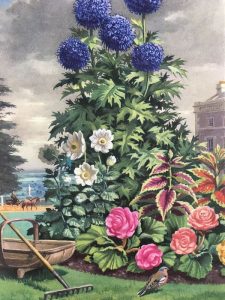 |
| Three John Leigh-Pemberton illustrations from ‘Garden Flowers |
Then there was the
Ladybird Book of Wild Flowers and here the scenes were very different. Human activity was barely visible or was shown in decay: a ruined monastery, a broken bridge.



The flowers were less bright and showy and had to battle harder on the page to gain my attention. The colours were more muted: lots of blues, palest pink with splashes of yellow. I wasn’t sure what I thought of wild flowers.
Both books were produced by Ladybird with the idea that they would be simple field guides, to be used by the curious child for reference and to stimulate their curiosity. On the left-hand side of every page was the name and description of the plants pictured. I’m sure lots of children used them in this way, but I don’t think I ever did. For me, the attraction was pouring over the details in the background. Who was in that carriage, coming up the drive. What was through that arch? Why was the bridge falling down?
 |
| ‘British Wild Flowers’ illus. Rowland and Edith Hilder |
Then there was
Indoor Gardening – a whole book dedicated to telling children like me that I too could be a gardener – as long as I had a window sill and an odd collection of containers: glass bottles, chipped pottery or an old teapot.
]
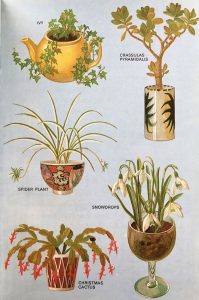
 |
| ‘Indoor Gardening’ illus. BH Robinson |
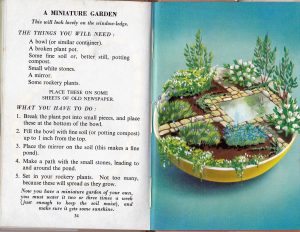 |
| ‘Things to Make’, illus. G Robinson |
But this looked too much like a school project to me – as did the helpful diagrams in
Plants and How they Grow. I
did have a go at making the ‘Minature Garden’ in
The Ladybird Book of Things to Make – but like all the projects in that book, when I’d finished it didn’t look anything like the picture.
Finally there was the magic of picking wild flowers. Yes, I know – and you must remember this, children – that we don’t pick wild flowers today. But in 1960s Ladybird Land it was fine to pick wild flowers. Goldilocks was filling her basket with bluebells when she discovered the Three Bears’ House. Little Red Riding Hood gathered an amazingly varied woodland bouquet to take to her grandmother.
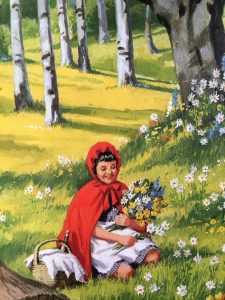 |
| ‘Little Red Riding Hood’, illus. Eric Winter |
 |
| ‘Goldilocks’, illus. Harry Wingfield |
Picking wildflowers was almost an emblem of childhood and freedom – a prelude to adventure and enjoyed equally by boys and girls. The sky was blue, there were no adults in sight, clothes never got dirty: and we never saw the miserable picked flowers in their vases and jam jars, wilting and withering only hours later.
That just didn’t happen in Ladybird Land.
 |
‘Prayers through the Year’, illus. Clive Uptton. ‘The Lord’s Prayer’, illus. Harry Wingfield |
I grew up and Ladybird Books grew up – and, for a time, I fared better than they did. I had a house with a garden and started to enjoy walks in the country and visits to garden-centres. Ladybird struggled with ever-increasing competition in the book market and, in the 1980s, swapped expertly-crafted artwork for much cheaper photography.
Looking back, I realise I did everything backwards. The books I grew up with were intended to help children identify the plants they saw around them. I don’t remember seeing plants around me when I was growing up, but later found myself identifying well-remembered Ladybird imagery in the landscapes of my adult life.
Perhaps on a walk in the country I’ll turn a corner and be confronted with a scene that transports me straight back to a page in
What to Look for in Spring or
Wild Flowers.
The pictures came first, and the plants came second. But one way or another the books of my childhood taught me to enjoy and to appreciate flowers, and in the end I don’t suppose it matters which way round it happens.
(This post was first published on Freddie's Flowers blog)
Learn more about vintage Ladybird books at Ladybirdflyawayhome.com
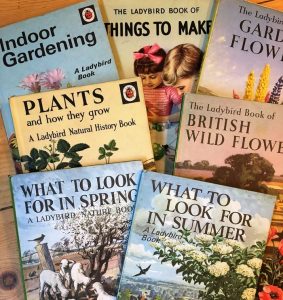


















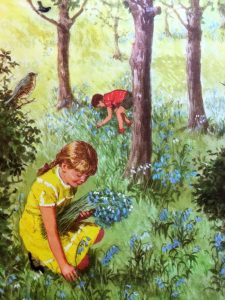

No comments:
Post a Comment